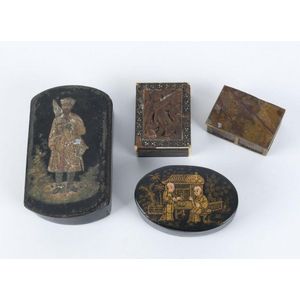18th Century Snuff Boxes (4)
Two chinoiserie papier mache snuff boxes, an Anglo-Indian snuff box and a French agate and ormolu snuff box, 18th century, (4 items), the largest 10.5 cm wide
You must be a subscriber, and be logged in to view price and dealer details.
Subscribe Now to view actual auction price for this item
When you subscribe, you have the option of setting the currency in which to display prices to $Au, $US, $NZ or Stg.
This item has been sold, and the description, image and price are for reference purposes only.
- Chinoiserie - Furniture and decorative items decorated in imitation of a Western interpretation of the Chinese style. The Chinoiserie style first became popular in the late 17th century, though there were frequent revivals, notably by Chippendale (hence 'Chinese Chippendale') during the Regency period, and the Anglo-Japanese style in the second half of the 19th century.
The ubiquitous 'willow pattern' is the most common 'Chinese' theme used in porcelain, while on furniture the Chinoiserie style usually has black or red painted and lacquered decoration, though the hallmark of the furniture style is the use of fretwork in geometrical patterns, pagodas and other decorative forms.
Japonaiseries, as the name implies, are motifs in imitation of the Japanese taste.
See also "Chinese Chippendale". - Agate - Agate is a type of semi-precious gemstone that is made up of silica dioxide, a mineral that is also found in quartz. It is known for its distinctive banded patterns, which are created as layers of silica are deposited in different colours including red, orange, yellow, green, blue, and purple. It is often used in jewellery, decorative objects, and other decorative items, and it is prized for its beauty and durability. Agate is found in many parts of the world, including Brazil, India, and the United States.
- Ormolu - Ormolu was popular with French craftsmen in the 18th and 19th century for ornamental fittings for furniture, clocks and other decorative items. True ormolu is gilt bronze, that is bronze that has been coated with gold using a mercury amalgam. Due to the health risks associated with using mercury, this method of creating ormolu was discontinued in France in the 1830s. A substitute was developed consisting of about 75% copper and 25% zinc, however it was inferior to the bronze version. It was often lacquered to prevent it tarnishing.
This item has been included into following indexes:
Visually similar items

A scrimshaw whale's tooth with Bonnie Prince Charles, 14 cm
Sold by
in
for
You can display prices in $Au, $US, $NZ or Stg.

Don Thornley, stoneware vase ash glaze with painted gestural decoration. Height 27 cm
Sold by
in
for
You can display prices in $Au, $US, $NZ or Stg.

Two 1oz bullion bars fine gold
Sold by
in
for
You can display prices in $Au, $US, $NZ or Stg.

A Victorian silver match box, engraved floral decoration, hinged, vacant panel to front; S Blanckensee & Sons Ltd, Birmingham, 1900. Weight 23.1g.
Sold by
in
for
You can display prices in $Au, $US, $NZ or Stg.
